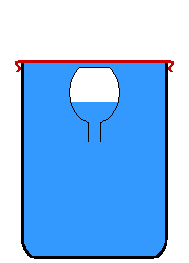- A ball point pen cap without a hole in the top (see fun fact at the end)
- Modelling clay
- A 1-liter water or soda bottle
- A bowl/bucket deep enough to have the diver float in
Magic Floater
Our bodies are considerably less dense than water. This causes us to float due to the air inside of us. However, we see scuba divers underwater all the time. How do they stay down? Divers make use of a weighted belt that they wear around their waist. The weight holds them underwater. They're also given a special piece of equipment called a buoyancy compensator. The scuba diver can adjust how much air is inside the buoyancy compensator to get control over their own density. This allows them to move down towards the ocean floor, or up towards the surface of the water.
In this experiment, you'll simulate the effects that a buoyancy compensator would have on a scuba diver.
What you'll need:
- A ball point pen cap without a hole in the top (see fun fact at the end)
- Modelling clay
- A 1-liter water or soda bottle
- A bowl/bucket deep enough to have the diver float in
Steps:
1. Fill the bowl about 3/4 full with water.
2. Roll some of your clay into a ball roughly the size of a marble.
3. Push the pointed end of the pen cap into the clay. The pen and clay together represent your diver.
4. Keeping the pen cap vertical, lower it into the bowl. Make sure the pen cap remains full of air while you do this. The picture to the right shows the orientation and direction the pen cap should be in, as well as the placement of the clay.
5. If the cap sinks to the bottom, you attached too much clay. If it floats, there isn't enough clay. Adjust the amount of clay till the top of the pen cap is standing just out of the water.
6. Fill your plastic bottle completely to the brim.
7. Remove the diver from the bowl, and insert it into the bottle using the same method.
8. Screw the lid onto the bottle.
9. There should be no air in the bottle besides the diver.
10. Squeeze the two sides of the bottle. You should see the diver sink. When you release the bottle, the diver should float to the top again. If you practice enough times, you will be able to keep the diver in the middle.
FUN FACT: There's a reason why many modern pen caps have a hole on top of them. Interested in learning more? Check out this link.
